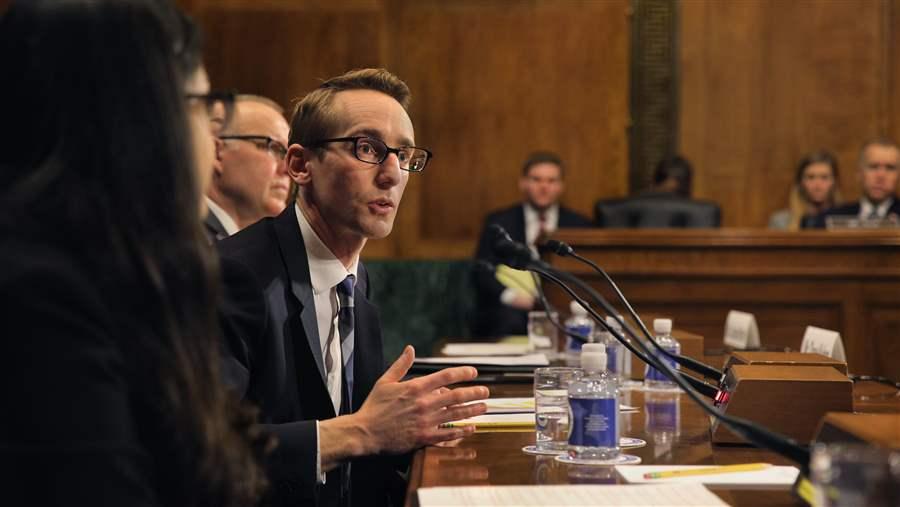States Take the Lead on Juvenile Justice Reform
Senate testimony highlights efforts to protect public safety, reduce costs

In several states, leaders from all three branches of government have worked together to improve their juvenile justice systems, dramatically reducing the number of youths sent to state custody while protecting public safety. Jake Horowitz, director of research and policy for Pew’s public safety performance project, testified about these reforms before the Senate Judiciary Committee on Feb. 28, 2017.
© The Pew Charitable Trusts
Ready for some good news? Juveniles in the U.S. are much less likely to be arrested for violent crime and committed to state custody than they were 15 years ago. From 2001 to 2014, the juvenile violent crime arrest rate fell 46 percent and, over roughly the same period, the rate at which youths were sent to state-funded facilities dropped 53 percent.
These improvements came about, in part, because many states worked to safely reduce the size of their juvenile correctional populations by prioritizing residential space for youth who commit the most chronic, violent offenses and by reallocating a portion of the resulting cost savings to evidence-based strategies that reduce recidivism.
In late February, I appeared before the Senate Judiciary Committee and testified that in six such states—Georgia, Hawaii, Kansas, Kentucky, South Dakota, and West Virginia—leaders from all three branches of government engaged in multiyear efforts to improve their juvenile justice systems, with support from The Pew Charitable Trusts. They formed cross-disciplinary work groups; analyzed local data and practices; developed policy recommendations; changed laws, court rules, and agency policies; implemented reforms; and tracked progress to make corrections and celebrate successes.
When reform is done well, the payoff can be enormous. Together, these six states have:
- Produced 30, 40, and even 60 percent reductions in the number of youths removed from their homes and sent to state custody.
- Closed five juvenile correctional facilities.
- Reinvested nearly $50 million in a range of community-based services.
Critically, these achievements come against a backdrop of improving public safety. In four of the states—Georgia, Hawaii, Kentucky, and South Dakota (those for which at least a calendar year of data is available)—juvenile arrests for serious crimes declined by an average of 10.3 percent compared with the year before the reforms were implemented.
Here’s what that means for one state: Georgia reduced mandatory minimum confinement periods, prohibited residential commitment for status offenders and some misdemeanants, and established a grant program to support counties that reduce the number of juveniles committed to state custody, among many other reforms, in 2013. Since then, the number of youth in secure confinement has fallen 36 percent, and total commitments to the Department of Juvenile Justice are down by almost half. Three facilities have closed, lawmakers shifted $30 million into community-based sentencing options, and judges and probation officers statewide now have access to at least one evidence-based program.
On March 24, Utah—the seventh state with which Pew has partnered—became the latest state to embrace reform when Governor Gary Herbert (R) signed comprehensive juvenile justice legislation to promote public safety; hold youth offenders accountable; control costs; reduce recidivism; and improve outcomes for juveniles, families, and communities. The law removes truancy from juvenile court jurisdiction; expands effective precourt alternatives; establishes presumptive lengths of time that youth can remain on probation, in out-of-home placements, and under the supervision of the court; caps fines and fees; and prioritizes restitution to victims over other financial obligations, among many other reforms. It is expected to cut the population of juveniles placed in state custody by 47 percent by 2022, compared with projected levels, freeing up more than $70 million over five years for reinvestment in evidence-based alternatives to incarceration.
Collectively, these seven states have passed reform packages that are projected to save $315 million over the ensuing five years. Support for the measures has been broad and bipartisan: Legislators have cast 888 yes votes compared with just 36 no votes, with 9 of 14 legislative chambers voting unanimously in support.
The bottom line is that states don’t need more correctional space to achieve less crime. In fact, they’ve protected public safety with dramatically lower levels of incarceration by aligning policies and resources with what the research indicates will produce the highest return on their juvenile justice investments.
Jake Horowitz is director of research and policy for The Pew Charitable Trusts’ public safety performance project.












